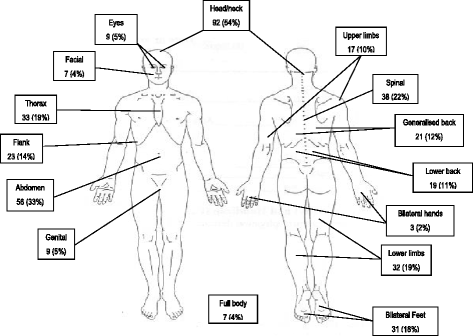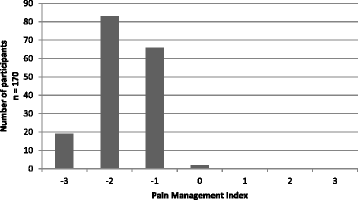Pain in amaXhosa women living with HIV/AIDS: a cross-sectional study of ambulant outpatients
- PMID: 28407737
- PMCID: PMC5390474
- DOI: 10.1186/s12905-017-0388-9
Pain in amaXhosa women living with HIV/AIDS: a cross-sectional study of ambulant outpatients
Abstract
Background: Pain is one of the most commonly reported symptoms in people living with HIV/AIDS, whether or not they are receiving anti-retroviral therapy. A recent systematic review identified a paucity of studies exploring pain in women in low and middle income countries. The prevalence and characteristics of pain in women living with HIV/AIDS may differ from that of men as many chronic pain conditions are more prevalent in women. The aims of this study were to establish pain prevalence, characteristics and management in amaXhosa women living with HIV/AIDS. In addition, we aimed to identify whether there were associations between pain in this population and the psychosocial factors of employment, education, self-efficacy, depression, post-traumatic stress disorder, health related quality of life and childhood trauma.
Methods: A cross-sectional study of 229 women who had undergone HIV testing and were registered patients at a community health centre was conducted. Data were collected by interview with a demographic questionnaire, the Brief Pain Inventory-Xhosa, Childhood Trauma Questionnaire-Xhosa, Harvard Trauma Questionnaire-Xhosa for PTSD, Self-Efficacy for Managing Chronic Disease 6-Item Scale-Xhosa; the EQ-5D health related quality of life instrument, and the Beck Depression Inventory.
Results: 170 of the women had pain, a prevalence rate of 74.24% (95%CI 68.2 - 79.47%). The women reported significant pain with pain severity of 5.06 ± 1.57 and pain interference of 6.39 ± 1.96 out of 10. Only two women were receiving adequate pain management according to the pain management index. Participants reported a mean of 2.42 ± 1.21 different anatomical sites of pain. There were more unemployed participants in the group with pain and they had significantly fewer years of schooling. Those with pain had lower self-efficacy; health related quality of life and increased depression and PTSD symptom severity.
Conclusion: This study highlights that pain is a common problem for amaXhosa women living with HIV/AIDS. These data emphasise the need to prioritise pain assessment and management in amaXhosa women living with HIV/AIDS. Routinely assessing for the presence of pain in women with HIV/AIDS has the potential to improve pain management and minimise the impact of pain on function.
Keywords: HIV/AIDS; Pain; Prevalence.
Figures
Similar articles
-
Pain in amaXhosa Women Living With HIV/AIDS: Translation and Validation of the Brief Pain Inventory-Xhosa.J Pain Symptom Manage. 2016 Jan;51(1):126-132.e2. doi: 10.1016/j.jpainsymman.2015.08.004. Epub 2015 Sep 5. J Pain Symptom Manage. 2016. PMID: 26344550
-
Managing pain in HIV/AIDS: a therapeutic relationship is as effective as an exercise and education intervention for rural amaXhosa women in South Africa.BMC Public Health. 2021 Feb 5;21(1):302. doi: 10.1186/s12889-021-10309-7. BMC Public Health. 2021. PMID: 33546647 Free PMC article.
-
Pain among ambulatory HIV/AIDS patients: multicenter study of prevalence, intensity, associated factors, and effect.J Pain. 2012 Jul;13(7):704-13. doi: 10.1016/j.jpain.2012.04.007. J Pain. 2012. PMID: 22748803
-
Pain in women with HIV/AIDS.Pain. 2007 Nov;132 Suppl 1:S13-S21. doi: 10.1016/j.pain.2007.10.009. Epub 2007 Oct 23. Pain. 2007. PMID: 17959310 Review.
-
Barriers to implementing clinical trials on nonpharmacological treatments in developing countries: lessons learnt from addressing pain in HIV.Pain Rep. 2019 Dec 6;4(6):e783. doi: 10.1097/PR9.0000000000000783. eCollection 2019 Nov-Dec. Pain Rep. 2019. PMID: 31984291 Free PMC article. Review.
Cited by
-
Pain-Specific Resilience in People Living With HIV and Chronic Pain: Beneficial Associations With Coping Strategies and Catastrophizing.Front Psychol. 2019 Sep 6;10:2046. doi: 10.3389/fpsyg.2019.02046. eCollection 2019. Front Psychol. 2019. PMID: 31555190 Free PMC article.
-
Prevalence, correlates, and quality-of-life outcomes of major or persistent pain among women living with HIV in Metro Vancouver, Canada.Harm Reduct J. 2024 Jan 13;21(1):10. doi: 10.1186/s12954-023-00859-x. Harm Reduct J. 2024. PMID: 38218886 Free PMC article.
-
Assessment of pain and associated factors in people living with HIV/AIDS.Rev Lat Am Enfermagem. 2019 Jul 18;27:e3155. doi: 10.1590/1518-8345.2803.3155. Rev Lat Am Enfermagem. 2019. PMID: 31340343 Free PMC article.
-
Distress is positively associated with induced secondary hyperalgesia in people with suppressed HIV.medRxiv [Preprint]. 2025 Apr 30:2025.01.27.25321015. doi: 10.1101/2025.01.27.25321015. medRxiv. 2025. Update in: Pain. 2025 Aug 7. doi: 10.1097/j.pain.0000000000003748. PMID: 39974111 Free PMC article. Updated. Preprint.
-
Functioning Problems Associated with Health Conditions with Greatest Disease Burden in South Africa: A Scoping Review.Int J Environ Res Public Health. 2022 Nov 24;19(23):15636. doi: 10.3390/ijerph192315636. Int J Environ Res Public Health. 2022. PMID: 36497710 Free PMC article.
References
-
- Mphahlele NR, Mitchell D, Kamerman PR. Pain in ambulatory HIV-positive South Africans. European Journal of Pain. 2011;16:447–58. doi: 10.1002/j.1532-2149.2011.00031.x. - PubMed
MeSH terms
LinkOut - more resources
Full Text Sources
Other Literature Sources
Medical




